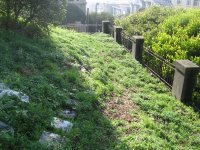
The first period class was reluctant today. Can’t really blame them since it was gray and drizzly. Second period was good—a core of students want to work in the garden so the momentum is good. It’s the first period group that complains endlessly. It started out gray but the sun unexpectedly came out, strong, warm and beautiful.
Nyra, Alex, Javone and Jose have been asking me about how they can grow plants at home in their own yards. So I’ve decided to focus on crop planning and research on plant needs. I put together a packet to guide students through the research. It includes a journaling guide for them to monitor their seed/plant over time. I think now that everyone has experience digging, planting, harvesting, it’s time to develop their own skills as gardeners, their continuity with the plants over time, and their own responsibility to the garden. I think they’re ready—maybe that’s what the complaining is starting to be about. Asking for influence.
So far, the students have really engaged with the research project, looking up plants in the Sunset book, seed catalogs and on the Internet. Learning scientific names, plant families, and crop origins. High expectations really pay off.
Another exciting opportunity—I was getting my delicious sandwich at
Eric’s Alamo Square deli down the block and I was telling him about the garden. He got very interested, talking about his mom’s garden back in Jamaica Plain and how all the neighbors had gardens. He asked if we were selling anything, said he could use red-leaf lettuce, cukes, peppers, tomatoes, a whole bunch of veggies. He’ll buy them from us! So I went back to school and told students and teachers, and they got VERY excited! Several teachers advised me on how to start a field study project. Ms. Friel even has an
entrepreneurship curriculum we can start with, to create a business plan and combine it with crop planning. Everyone’s talking about it.
It was great to have the teachers’ advice on how make the work the right level, the right amount, and the right balance between independent work and a group project. There’s SO much potential in this neighborhood to sell produce or even run a market cart near the park. This is going to be great.
entrepreneuryouth entrepreneurship






